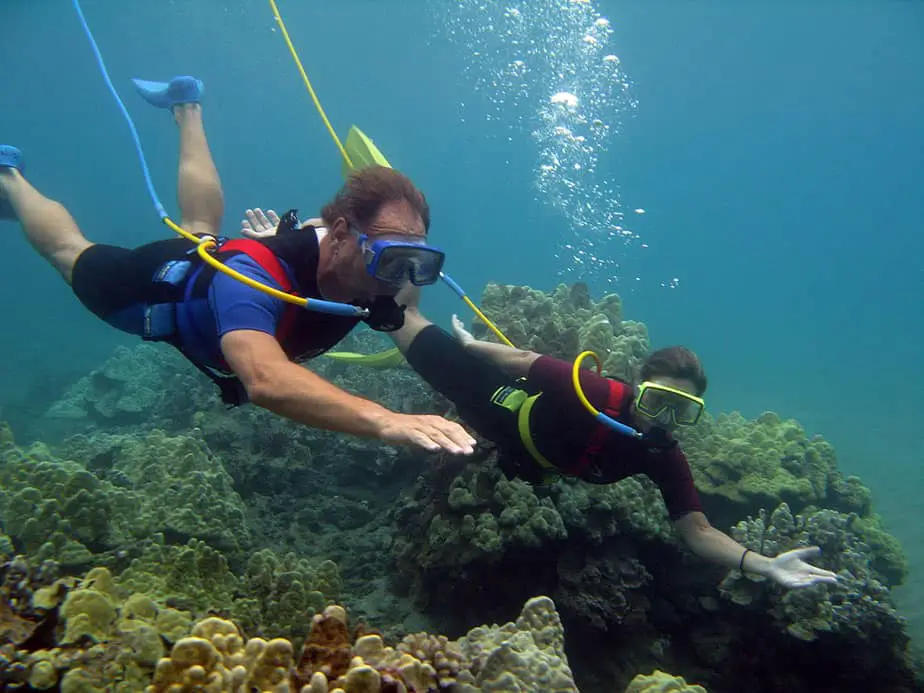If you want to explore below the ocean, you might think your only options are snorkeling and SCUBA diving. However, there is another one called SNUBA diving (not to be confused with SCUBA) which you may be interested in. It’s often described as a hybrid of snorkeling and SCUBA diving. Plus, almost anyone can do it and it doesn’t require you to get a certification. Read on to find out more about SNUBA diving.
What is SNUBA diving?
SNUBA diving is like a cross between SCUBA diving and snorkeling. It is a great way to feel like you’re scuba diving without needing to get certified. SNUBA has been around since 1988 and has given millions of people the convenience and fun of SCUBA in a safe, controlled environment.
Underwater activities typically require one to take intensive classes and familiarize themselves with lots of gear and terminology. With SNUBA, all you really need to know is how to swim, and the tour guide will teach you how to do the rest. You will be diving in a carefully selected shallow environment that is filled with marine life. The maximum depth is usually 20 feet, and you will be able to experience many of the same sights SCUBA divers and snorkelers do.
Furthermore, SNUBA diving is a great opportunity to take your friends and family if you want to do something a bit more intense than snorkeling but not quite on the same level as SCUBA diving. It can give prospective divers a small look into what SCUBA diving is like, and on top of that, it’s just so dang fun to do as a recreational activity on a vacation.
You can find SNUBA diving locations all over the world, so consider going SNUBA diving on your next vacation.
SNUBA vs. SCUBA vs. Snorkeling
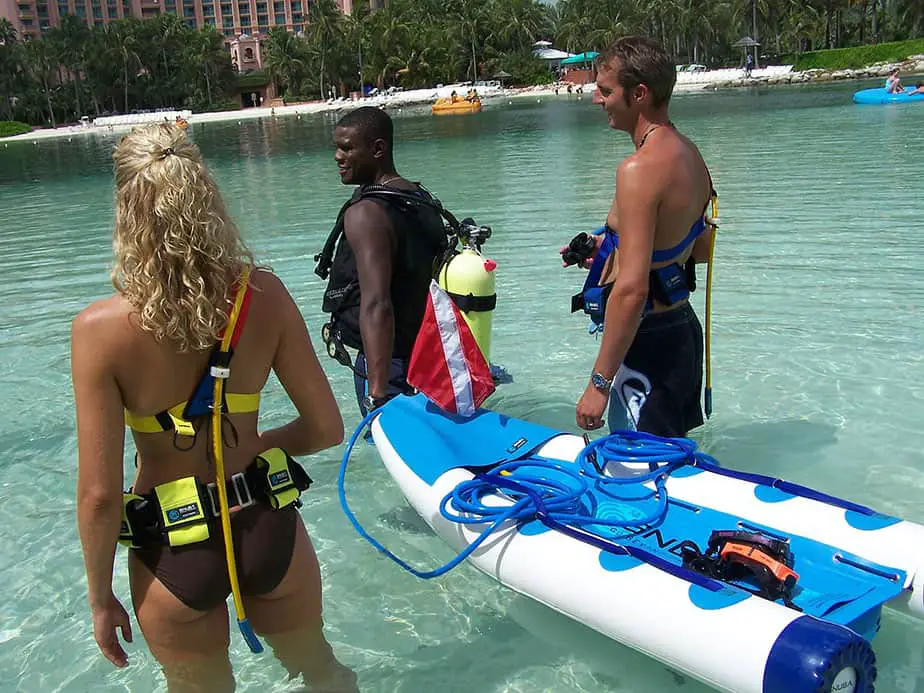
When we go on vacation to a tropical destination like Maui or the Bahamas, one of the things we want to do is to explore the ocean below. You’ve seen the videos and photos. Looking at, or even swimming with, all of the colorful marine life and the coral reef can provide some unforgettable memories.
Snorkeling
A popular, low-cost, and accessible activity that people do to experience the underwater world is snorkeling. With a snorkel one can breathe underwater by the water’s surface and get a view of the underwater world without needing to lift their head up. The downside of snorkeling is that you have to stay by the surface if you don’t want the snorkel to be submerged.
Furthermore, many fish and coral reefs are found at depths greater than 5 feet, which is deeper than most people are willing to swim down to. With snorkeling, you can only look from afar and many people want to be swimming up close to the fishes. So the next thing they consider is SCUBA diving.
SCUBA diving
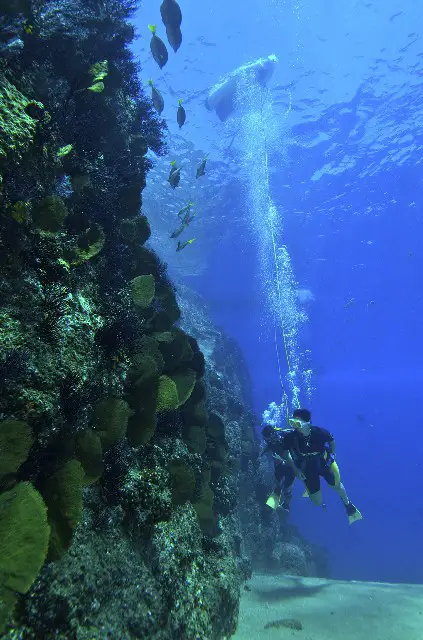
People who wish to dive deeper and spend longer underwater lean towards SCUBA diving. However, this activity requires taking courses and getting certified. It also requires plenty of gear and can be quite expensive in the long run. Not everyone wants to make such a huge investment in terms of time and money. If only there were a cheaper option?!
The barrier to entry for SCUBA diving is quite high. However, once you are certified, the effort will be worth it. Using a tank of air and a regulator, recreational SCUBA divers can dive down to about 60 feet underwater. Here, they can explore parts of the ocean that snorkelers and SNUBA divers can’t.
Unfortunately, many people are not suited to diving. There are many risks involved, including the risk of nitrogen narcosis, decompression sickness, and lung barotrauma. If you are not physically fit, it’s going to be very dangerous. Furthermore, if you have a pre-existing medical condition and suffer a medical emergency while underwater, even with a dive buddy looking after you, the chances of death are very high.
With that said, nowadays scuba diving is considered a very safe water activity if you know what you are doing. That is why you should take scuba diving lessons and earn yourself a scuba diving license. SCUBA licenses never expire, and while this may sound good, it also means that it’s possible for some divers to take extended breaks and forget many of the basics. In that case, it’s best to take a refresher course to get you back up to speed.
The people best suited for SCUBA diving are adventurous types that are strong swimmers with no medical conditions. They are people who are willing to travel all over the world to interesting SCUBA diving destinations or to participate in liveaboards.
SNUBA
After reading a bit about SCUBA diving, can you begin to see the niche that SNUBA diving fills? It’s for people who want a bit more than snorkeling, but who don’t want to commit fully into SCUBA diving.
Let’s start with some of the pain points about SCUBA diving that SNUBA diving solves.
- You don’t need to be certified.
- You can stay at the surface or dive all the way down to 20 feet. Better than snorkeling in this regard, but loses out to SCUBA diving.
- You don’t need to purchase any gear or lug any heavy equipment around.
- You don’t need to invest much into this hobby and can drop it at any time. Divers who own plenty of gear (e.g. wetsuit, dive computer, regulator, etc.) need to be absolutely sure they will get good use out of them over the years.
- Anyone can do it: kids 6 years and older, couples on a honeymoon, seniors, etc.
To get started with SNUBA diving, all you need is a 15-minute safety instruction and then you are ready to go on a tour with a SNUBA guide. If SCUBA diving appeals to you but you don’t want to get certified, then give SNUBA diving a shot. You will be able to explore and swim close to your resort’s or hotel’s beach for an affordable price compared to SCUBA diving.
How does SNUBA diving work?
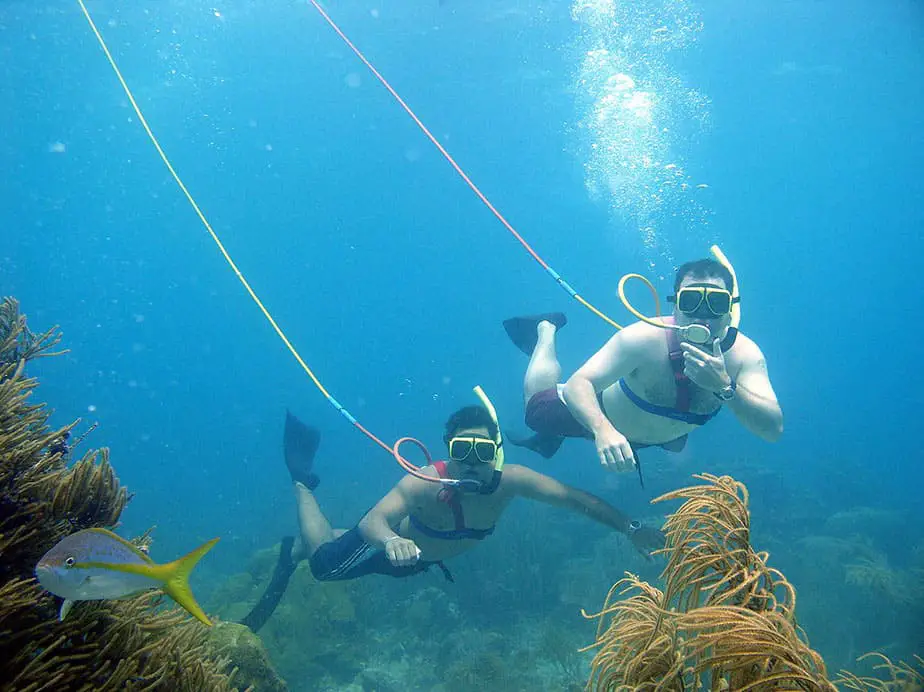
SNUBA diving is like SCUBA diving but instead of carrying your air supply with you, it’s left on a raft at the surface. Your regulator is connected to this air supply via a 20 foot long air hose. Snorkelers, if you’ve ever wanted to use an extra long snorkel, this is the closest thing to it. This is how SNUBA divers can breathe underwater without having a cumbersome tank on their back and this makes it easier to swim underwater.
The average length of a SNUBA dive is approximately 20-25 minutes. The actual length will vary slightly from person to person. Basically, you are limited by how much air is remaining in the tank. The calmer you are and the slower you breathe, the longer your dive will last.
One of the main appeals of SNUBA is how accessible it is – SNUBA locations can be found worldwide. Also, many people who SNUBA dive have never dived in their life. They may not even have snorkeled or taken a breath underwater before. And that’s okay! With SNUBA, you will be able to have free reign of the ocean to depths down to 20 feet which for many people is a massive upgrade and a wonderful experience.
It’s up to you how deep you want to dive. You can enjoy it at the surface like a snorkeler, you can go down to 2 feet, 10 feet, or even 20 feet and feel what it’s like to be a SCUBA diver. You can experience all of this with no certification necessary, and you don’t even have to bring your own gear!
SNUBA gear
With SNUBA, you don’t even have to bring any gear with you. The SNUBA company will provide all of the equipment that you need. There are six pieces of gear that you will be using:
- A long airline that leads to the tank on the surface.
- SCUBA mask to provide a clear window of marine life.
- Regulator so you can breathe underwater.
- Harness that ensures the airline is strapped to you.
- Weight belt to help you achieve neutral buoyancy so you aren’t going up or down.
- Fins to give you more powerful kicks so you can swim freely.
Notice how we did not include the air tank as part of this list? That’s because you won’t even be carrying it with you, so it’s not something you need to worry about. Not having the bulk of the tank makes it much easier to swim around and you will enjoy the freedom it provides.
Who can SNUBA?
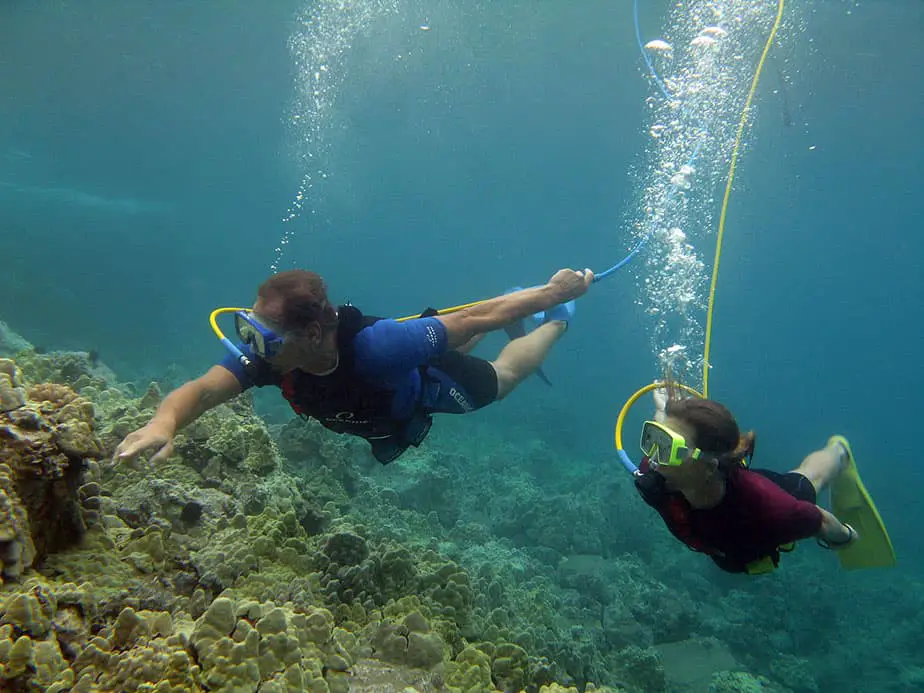
SNUBA diving is easy to do, safe, and does not require a SCUBA certification. You do not need to have any SCUBA or snorkeling experience, and you don’t have to be a particularly strong swimmer either, though swimming experience is recommended. Basically, if you are not afraid to jump into the deep end of a pool, your swimming skills are adequate.
One of the great things about SNUBA diving is how accessible it is. Almost anybody can do it: couples, families, children six years of age and older, even seniors. As we mentioned, it does not require a certification and all of the gear is provided to you. It’s also a good way for a certified diver to introduce a non-certified buddy a glimpse of what it’s like to go SCUBA diving.
Frequently asked questions
What does SNUBA stand for?
The SNUBA acronym stands for Surface Nexus Underwater Breathing Apparatus. For comparison’s sake, SCUBA stands for Self Contained Underwater Breathing Apparatus. Which one sounds cooler?
Are there medical requirements for SNUBA diving?
Yes. With that said, the medical requirements for SNUBA are much more relaxed compared to SCUBA diving. However, there are still medical requirements, and you will have to meet the SNUBA company’s standards in order to be allowed to dive.
How long does a SNUBA dive last?
Approximately 20-30 minutes depending on the individual. Try to remain calm, control your breathing, and keep your heart rate low. Too much physical exertion will cause you to increase your air consumption, thereby shortening your bottom time. In general, men cannot stay underwater as long compared to women due to their larger size and increased oxygen consumption.
How deep can I dive?
The maximum depth is 20 feet. It’s up to you how deep you want to dive. You can spend most of it at only 2 feet, 5 feet, 10 feet, or go all over the place. You’ll be carrying dive weights so that you are neutrally buoyant (neither ascending nor descending) so you don’t need to worry about controlling your buoyancy.
What is the minimum age for SNUBA diving?
It depends on the SNUBA company, but children as young as 6-8 years of age may be allowed to SNUBA dive.
Can I surface whenever I want to?
One of the risks for SCUBA diving is going back to the surface too quickly and without performing any stops. Thankfully, the depths reached in SNUBA diving are shallow enough that this is not much of an issue, though it’s still preferred that you stay underwater for the duration of the dive.
If you want to surface in order to clear your mask, grab a camera, get a drink of water, or to simply take a rest, the key things to remember are to ASCEND SLOWLY and NEVER HOLD YOUR BREATH. Ascend no faster than the speed of your bubbles, and keep breathing normally at all times.
Do I need snorkeling experience to SNUBA?
No, but it doesn’t hurt to have it. Plenty of people have successfully dived without prior snorkeling experience. The biggest adjustment is getting used to breathing with your mouth and conditioning your brain to take deep breaths while underwater.
In a similar vein, you don’t need to be a strong swimmer to SNUBA either. If you’re comfortable swimming in water where your feet can’t touch the ground, then you’ll be fine here too.
Can I fly in an airplane after SNUBA diving?
Not immediately. Taking a page from SCUBA diving guidelines, there is a risk of decompression sickness (the bends) if you go to altitude immediately after a dive. Even though SNUBA depths are shallow enough that you can surface without decompressing, there is still a risk of getting the bends. You should wait for at least 4 hours before going on any aircraft or driving to high altitudes after SNUBA diving.
Photo Credits (CC BY-SA 3.0):

